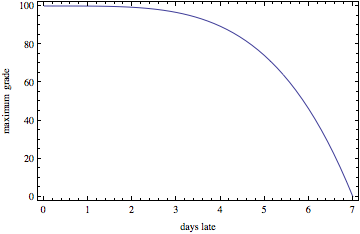How to Set Deadlines for Your Students

I’m very deadline driven. So much so that I go to truly ridiculous lengths to impose deadlines on myself. The truly ridiculous lengths are needed, of course, because self-imposed deadlines are notoriously prone to getting weaseled out of. There’s another kind of deadline that is also notoriously prone to getting weaseled out of: instructor-imposed deadlines. It’s a sad fact of academia: Students with too much self-respect to ask for special treatment are penalized relative to those who do. In other words, you can get away with murder by whining to the instructor. As an instructor it’s very hard to neutralize the whining strategy without feeling like a heartless jerk.
Why Deadlines? [1]
You may well ask why instructors should penalize late submissions at all. First, it’s just a practical issue for the instructor: you don’t want to grade everything at the end of the semester. But more importantly, it induces the students to spread their effort out over the whole term. The best instructors I know maximize the number of intermediate deadlines. Here’s how David Reiley put it:
When my students have a term paper, I give them a deadline to turn in a proposal, a deadline to turn in a first draft and share with their classmates, and a deadline for their final version. They learn a lot more that way. Same thing with giving them nearly weekly problem sets instead of just a midterm and final.
And the best students understand this, too. Dan Ariely describes in his book, Predictably Irrational, an experiment with his students relating to deadlines and commitment devices that drives home the point. The setup is that he let his students pick their project deadlines for the whole semester. Once they were picked the students would fail if they didn’t meet them. So rationally they should choose all the deadlines to be on the last day, to maximize flexibility. But you won’t be surprised by the punchline: Students who precommitted to spaced-out deadlines did better.
The key is to reduce the burstiness of effort. Especially enterprising students can overcome their procrastinating natures on their own, given the right tools.
Late Day Budgets
Now that we’ve established that deadlines are good, let’s get back to the problem of being sensitive to the need to occasionally miss them without having to stray from a universal policy. A common solution is to deduct points for each late day. Such a policy, however, requires rather harsh penalties (e.g., 1/2 grade off per day late) in order to ensure assignments are not turned in weeks late. An alternative is to give every student a budget of free late days to be used throughout the course. With this built in flexibility, students can use their allocation of late days without offering up any excuses. But that solution only goes so far. You’ll occasionally have students who run out of late days but still feel they have a good excuse, or who miss the deadline by just a little and argue that it shouldn’t count as one of their late days. Just being day-based means you’ll end up having to make judgment calls (or be draconian) about when exactly the transition from n to n+1 days late happens.
“It’s socially inefficient!”
And there’s an even bigger problem with the late-day budget. It’s socially inefficient! Students are incentivized to be conservative with their late days early in the semester and then have late days to burn at the end. What you really want is efficient late submitting: students should take only as much extra time as they need (to a point).
A Graduated Penalty Function [2]
Here was my solution to this problem, from the syllabus of the last class I taught:
If an assignment is late by t seconds then the score will be adjusted by multiplying by $$1-\left(\frac{t}{7\cdot 24\cdot 60\cdot 60}\right)^4$$ which is just \(1-t^4\) if \(t\) is measured in weeks. This policy is applied totally automatically based on the submission timestamp. Note that within two days of the deadline less than 1% — \((2/7)^4\) — of the points are lost so the late policy can be treated as having essentially a 2-day grace period for every assignment. Because of that built-in leeway, the only exceptions will be for serious emergencies. Most excuses will not warrant a manual override of the late policy. Once the nominal deadline has passed, no resubmissions will be allowed. So when submitting during the variable penalty period, check over your submission carefully.

Note that the multiplier is zero after exactly one week. The reason for not allowing resubmissions after the nominal deadline is that otherwise you couldn’t start grading until a week later, when all the points are gone.
The beauty of this late policy is that you never have to make judgment calls — where you end up rewarding whining — yet you don’t have to feel like you’re being anal and inflexible. There’s more automated flexibility built in than with a late-day budget. And by eliminating the discontinuities in the penalty at the day boundaries, there’s no such thing as quibbling about what fluke technical difficulty delayed submission at some critical moment. Most importantly, with a late penalty that starts out negligible and gradually, smoothly transitions to severe, students are incentivized to target the nominal deadline and take as much additional time as they truly need, subject to the constraint that you don’t have to worry about stragglers beyond a week. And despite what is essentially a 2-day grace period on every assignment, I found that most students met the nominal deadline.
Footnotes
[1] Some pedagogy nerds may object that late penalties, by reducing grades due to lateness, make grades less reflective of what was truly learned. That’s true, but the failure to spread work out harms actual learning so harming the meaningfulness of the grades is a small price to pay.
[2] The sort of Messy Matters readers who read our footnotes may be wondering why Beeminder doesn’t use a graduated penalty function. In some sense it does, in that you go from the green zone to the blue zone (right lane of the yellow brick road) to the orange zone (wrong lane of the yellow brick road) to the red zone (emergency day) before finally getting charged for going off track. But it’s true that the penalty incurred for derailing happens all at once at a certain time. That may be draconian but it’s exactly what Beeminder users are signing up for. Still, it’s not a bad idea! I hadn’t actually considered it till writing this blog post, which I intended to be entirely unrelated to Beeminder!
Ironically fitting illustration by
Kelly Savage.
Thanks to David Reiley,
Sharad Goel,
Bethany Soule,
Nicci Nunes, and
Kevin Lochner for
comments.
